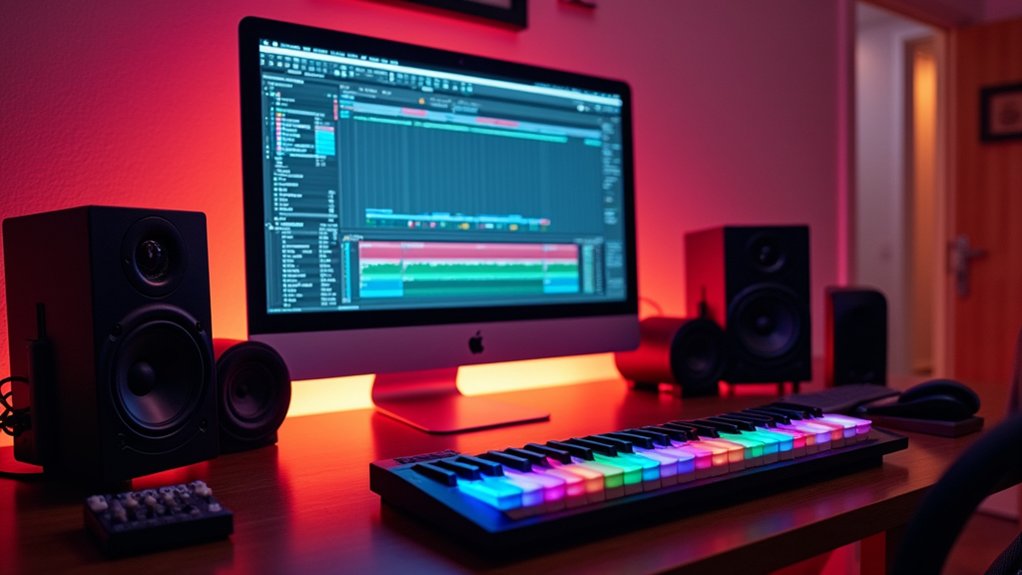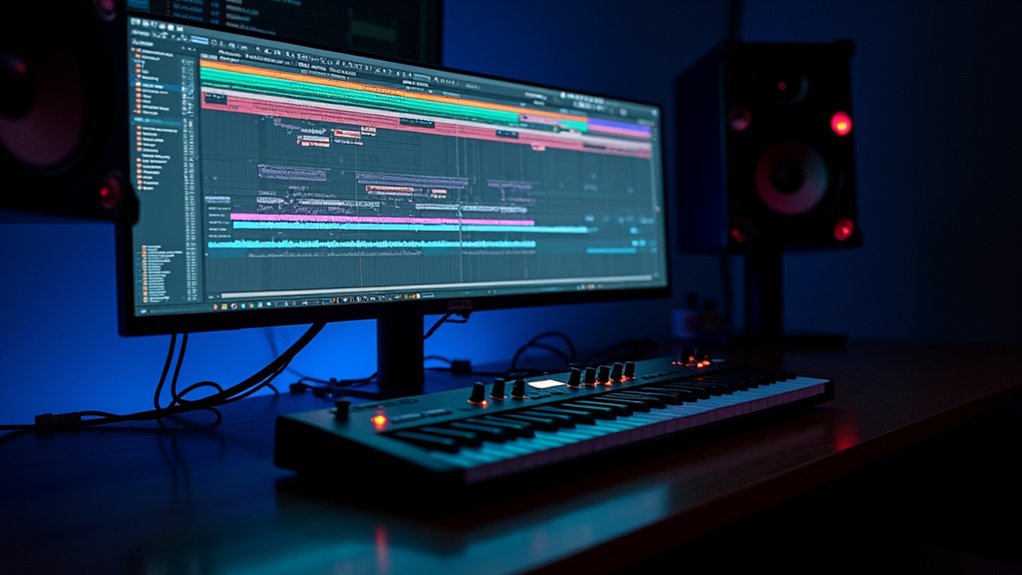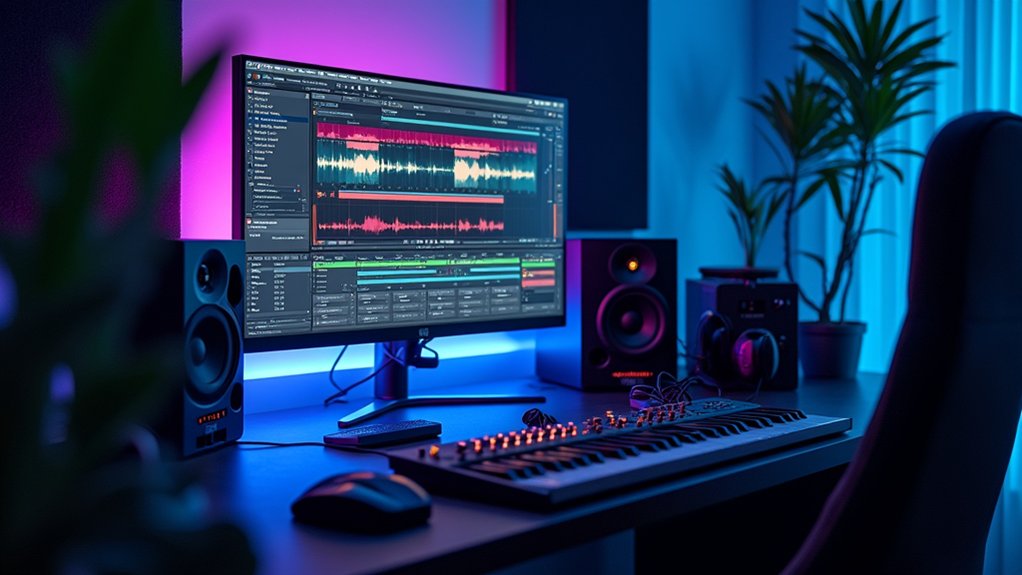To add samples to FL Studio, users first configure their sample folders in File Settings under “Browser extra search folders.” Any designated folder appears in the FL Studio browser for quick access. Simply drag samples from the browser directly into the Playlist or Channel Rack to trigger playback and begin arranging immediately. This workflow encourages creative sampling and fast project building. For greater efficiency and deeper sample integration, organized library management and advanced auditioning techniques can be explored further.
Key Takeaways
- Open the FL Studio browser and navigate to your sample folders for easy access.
- Drag and drop any audio sample directly from the browser into the Playlist or Channel Rack.
- Instantly audition samples by clicking them in the browser before dragging them into your project.
- Organize your sample library in “Browser extra search folders” for fast retrieval and efficient workflow.
- Arrange, layer, and manipulate dropped samples in the Playlist or Channel Rack using FL Studio’s built-in tools.
Accessing FL Studio’s File Settings
To efficiently manage and access custom samples within FL Studio, users must first configure the software’s file settings. By traversing to the “Options” menu in the top left of the interface, and selecting “File settings,” users open the gateway to streamlined sample integration.
Within the file settings window, the “Browser extra search folders” section enables the addition of custom sample packs, allowing users to specify directories where FL Studio will look for audio content. Utilizing the adjacent folder icon, users can select their sample folders without manually entering paths, optimizing setup speed.
Organizing sample packs in a dedicated folder—such as “my samples”—ensures quick access and categorization. This targeted configuration directly contributes to speed up your workflow, promoting a more efficient and organized creative process.
Setting Up Your Sample Library Folder
A well-structured sample library serves as the backbone of efficient music production within FL Studio.
To set up a robust foundation, users should access the “Options” menu and select “File settings.” Within the “File settings” window, the “Browser extra search folders” box enables the linking of a dedicated sample directory.
By clicking the folder icon, producers can choose their preferred location—commonly a specifically organized “my samples” folder. Consolidating all sample packs inside this folder streamlines navigation; the entire collection appears under “my samples” in the FL Studio browser, expediting sound selection and fostering a smoother creative process.
For additional guidance, refer to the link in the description. This approach not only optimizes workflow but also guarantees long-term sample management and rapid auditioning. Regularly rescan for new additions to ensure your sample library is always up-to-date and efficiently organized.
Adding Sample Packs to Your Collection
Selecting high-quality sample packs is vital for maintaining a professional sound palette and maximizing creative potential in FL Studio.
Organizing these packs within a logical folder structure—such as by genre, instrument, or producer—streamlines access and keeps the workflow efficient.
Regularly updating and curating the sample library guarantees ongoing inspiration and prevents clutter from hindering the music production process.
Choosing Quality Sample Packs
Diversity in sound selection drives creative potential within FL Studio, making the choice of quality sample packs a critical step in music production workflow.
Prioritizing sample variety importance guarantees producers have access to a broad spectrum of sounds—ranging from genre-specific kits to experimental textures—enhancing compositional flexibility.
Audio quality significance cannot be overstated; selecting packs with high-resolution files (24-bit/96kHz) preserves sonic detail and headroom, allowing for intricate mixing and professional-grade output.
Evaluating producer reputation impact is equally essential; well-known sound designers or established companies typically deliver reliably curated content, minimizing risk and streamlining the creative process.
User reviews and ratings further inform selection by highlighting practical usability.
Including packs with both one-shots and loops maximizes adaptability when crafting unique arrangements.
Folder Structure Best Practices
Establishing a well-organized folder structure is fundamental for efficient sample management in FL Studio, directly impacting workflow speed and creative flow.
A dedicated “my samples” folder serves as the central repository for all sample packs, simplifying file management and access.
Employing sample categorization techniques such as genre based organization or grouping by sample type (e.g., drums, synths, vocals) allows producers to quickly locate desired sounds.
Effective folder naming conventions—using descriptive, consistent names—further reduce search time and confusion during the creative process.
Integrating these folders into FL Studio’s browser via the “browser extra search folders” feature guarantees seamless access without manual path entry.
Updating Your Sample Library
As new creative needs arise or fresh inspiration strikes, maintaining an up-to-date sample library is vital for maximizing efficiency in FL Studio. Users should navigate to the “Options” menu and select “File Settings” to add new sample pack locations, specifically under the “browser extra search folders” section. Creating a dedicated “my samples” folder guarantees organized access to diverse sample formats, sample genres, and sample effects. Utilizing the folder icon streamlines this process, eliminating manual path entry. After setup, samples can be browsed and auditioned directly within FL Studio and quickly integrated into projects.
| Sample Format | Sample Genres | Sample Effects |
|---|---|---|
| WAV, AIFF | Hip Hop, EDM, Trap | Reverb, Distortion |
| MP3, FLAC | House, Pop, Rock | Delay, Chorus |
| OGG | Lo-Fi, Jazz, Cinematic | EQ, Compression |
| REX2 | Dubstep, Funk | Filter, Flanger |
Configuring Browser Extra Search Folders
Configuring browser extra search folders in FL Studio begins with accessing the “File settings” menu, where users can specify custom sample paths to expand their library. By strategically organizing folders—such as consolidating sample packs into a dedicated directory—workflow efficiency is greatly enhanced. This setup guarantees that all added samples are immediately available in the FL Studio browser for seamless creative access. Utilizing pre-existing audio material as foundational elements can further enhance productivity and streamline the creative process.
Efficiently managing sample libraries in FL Studio begins with precise navigation of the File Settings menu, where users can define custom directories for their sound collections.
Accessing this crucial hub requires selecting “File Settings” from the “Options” menu, which reveals the central location for configuring browser extra search folders.
For advanced file management tips, users should focus on the “Browser extra search folders” box, a dedicated area for specifying additional sample directories.
By clicking the folder icon adjacent to this box, one can select folders visually, eliminating manual path entry and reinforcing sample organization strategies.
Establishing a “My Samples” folder here guarantees streamlined access, directly supporting optimizing workflow efficiency.
Once configured, samples are immediately accessible from the browser, accelerating creative decision-making and production throughput.
Adding Custom Sample Paths
Streamline sample integration in FL Studio by specifying custom paths within the “Browser extra search folders” section of the File Settings menu.
Users begin by traversing to “Options,” selecting “File settings,” and locating the “Browser extra search folders” box. Utilizing the adjacent folder icon, they can select desired directories for sample path optimization, eliminating the need to manually input file locations.
Establishing a dedicated “my samples” folder supports custom folder organization, ensuring all sample packs reside in a centralized, easily accessible location.
Once custom paths are added, FL Studio’s browser instantly indexes these folders, enabling efficient browsing techniques for sample auditioning and selection.
This approach accelerates workflow, allowing for rapid drag-and-drop deployment of samples directly into a project, fostering creative momentum.
Managing Folder Organization
A well-structured sample library is essential for maintaining an efficient workflow in FL Studio. To implement effective sample organization strategies, users should navigate to “Options” > “File Settings” and configure the “Browser extra search folders” section. By selecting a dedicated “my samples” folder, all sample packs remain consolidated, simplifying access and management. Employing clear folder naming conventions—such as genre, instrument, or producer—further enhances efficient browsing techniques and minimizes time spent searching for sounds. This organization not only accelerates workflow but also supports creative momentum during music production.
| Step | Benefit |
|---|---|
| Set “my samples” folder | Centralizes sample library |
| Use descriptive names | Enables quick identification of content |
| Structure by category | Facilitates efficient browsing techniques |
Many producers rely on the FL Studio browser as a central hub for organizing and accessing their sample libraries. The browser features intuitive navigation, allowing users to structure folders for streamlined workflow.
By utilizing FL Studio shortcuts, such as the F10 key to access file settings or right-clicking to quickly collapse directories, producers can optimize their browsing experience. Adding custom folders—like a dedicated “my samples” location—ensures quick retrieval and improved project organization.
The browser supports sample auditioning with a single click, instantly previewing sounds without loading them into the project. To integrate samples, users simply drag and drop files from the browser directly into the playlist or channel rack, maximizing efficiency and encouraging creative spontaneity during the composition process.
Auditioning Samples Before Use
Efficiently previewing samples is essential for maintaining a smooth production workflow in FL Studio. By utilizing the browser’s built-in auditioning techniques, producers can quickly implement sample selection strategies without interrupting their creative momentum. Clicking on any sample within the browser instantly plays back the sound, enabling immediate sound quality evaluation. This streamlined feedback loop allows for rapid comparison and sonic decision-making, ensuring only the most suitable sounds proceed to arrangement. Auditioning samples before use not only saves time but also enhances the overall composition process by filtering out less effective options early. The following table outlines the core benefits and workflow steps:
| Step/Strategy | Workflow Benefit |
|---|---|
| Browse library | Quick access to samples |
| Click to audition | Instant sound preview |
| Compare different samples | Informed selection |
| Evaluate sound quality | Higher production standards |
| Refine selection iteratively | Efficient creative workflow |
Dragging Samples Into the Playlist
After selecting the ideal sample through the browser’s auditioning features, the next logical workflow step involves integrating that sound directly into the project’s arrangement.
Employing efficient dragging techniques, the user simply clicks and holds the left mouse button on the sample, then moves it to the desired position in the playlist window. This direct action enables immediate engagement with playlist organization, allowing samples to be dropped onto any track for flexible structuring.
Sample layering becomes intuitive, as multiple sounds can be stacked or arranged across tracks to build dynamic sections. The drag-and-drop method not only accelerates the creative process but also inspires inventive arrangements.
- Harness instant creative momentum by using intuitive dragging techniques.
- Achieve meticulous playlist organization for professional results.
- Explore boundless possibilities with advanced sample layering strategies.
Placing Samples in the Channel Rack
To integrate samples into the channel rack, users drag their chosen audio files from the browser directly into an empty channel slot.
This method not only streamlines sample placement but also sets the stage for efficient channel organization.
Renaming and arranging channels within the rack enhances workflow, allowing for faster identification and manipulation of sounds during production.
Dragging Samples to Rack
Dragging a sample from FL Studio’s browser and dropping it onto an empty slot in the Channel Rack instantly integrates the sound into the project’s workflow.
This direct method not only accelerates the creative process, but also provides immediate access to sample customization techniques.
Once placed, each sample can be individually tailored—adjusting volume, pitch, or routing effects—empowering unique sound design.
Integration with a MIDI controller enables users to trigger samples for real time performance, enhancing expressive potential.
Auditioning samples beforehand guarantees only the most fitting sounds enter the Channel Rack, streamlining further arrangement.
- Effortless placement guarantees an uninterrupted creative flow.
- Deep customization invites unique pattern creation.
- MIDI controller integration fuels real time performance, inspiring spontaneous creativity.
Organizing Channels for Workflow
Once samples are introduced into the Channel Rack, effective organization becomes fundamental for an efficient workflow.
Channel customization is achieved by dragging each desired sample from the browser into an empty channel slot, allowing for unique effects, volume, panning, and pitch settings per sample.
For workflow optimization, users can quickly rearrange samples within the Channel Rack via simple drag-and-drop actions, placing similar sounds together for easier management.
Sample grouping—such as aligning drums, percussion, and melodic elements sequentially—streamlines the arrangement process and enhances visual clarity.
This systematic approach guarantees rapid access to all samples, facilitating precise mixing and arrangement.
Through utilizing channel customization and thoughtful sample grouping, producers can minimize workflow bottlenecks and maintain creative momentum throughout the production process in FL Studio.
Organizing Samples for Quick Access
Although FL Studio provides access to a vast array of sounds, workflow efficiency hinges on a well-organized sample library.
Employing systematic sample organization strategies, such as consolidating all sample packs into a dedicated “my samples” folder, minimizes time spent searching and maximizes creative focus.
Using clear folder naming conventions—like labeling by genre, drum type, or instrument—streamlines navigation within FL Studio’s browser.
Utilizing the “file settings” menu to add this folder as an extra search location further accelerates the process, enabling quick navigation tips like single-click access to all resources.
- Create a central “my samples” directory for total order.
- Implement intuitive folder naming conventions for instant recognition.
- Use FL Studio’s file settings for seamless, frustration-free access.
Experimenting With Sounds in Your Project
After configuring FL Studio’s browser to access a well-organized sample library, users can efficiently experiment with sounds by auditioning samples directly within the browser. By clicking on samples, they preview how each element fits into the evolving arrangement. Dragging a selected sample into the channel rack or playlist enables immediate integration. This workflow encourages the use of sound layering techniques, allowing users to stack percussion, melodies, or textures for depth. Creative sample manipulation—such as pitch shifting, applying effects, or time-stretching—further expands sonic possibilities, resulting in unique sound combinations. The audition feature streamlines the process, facilitating rapid trial and error for refined sound selection. Experimentation within this environment becomes both systematic and creatively open-ended. Understanding the importance of proper setup and configuration impacts the quality of your recordings and overall production.
| Technique | Workflow Step | Creative Result |
|---|---|---|
| Audition samples | Browser click | Instant preview |
| Sound layering | Drag/drop to playlist | Richer textures |
| Sample manipulation | Apply FX, edit | Unique sound combinations |
| Placement adjustment | Move in playlist | Dynamic arrangement |
Tips for Efficient Sample Management
A streamlined sample management system directly supports creative experimentation in FL Studio by reducing search time and workflow interruptions. Effective sample pack curation begins with creating a dedicated “my samples” folder and consolidating sample types into organized subfolders—drums, vocals, effects. Utilizing FL Studio’s “file settings” to add this folder as a browser extra search folder further enhances accessibility. Regularly auditioning samples in the browser helps producers make sound design techniques more intentional, ensuring each element fits the project before use. Organizing your drum collection by creating subfolders based on style or genre can further streamline your workflow. Embracing these creative workflow tips allows for rapid experimentation and arrangement.
- Organize with purpose: Structure folders for instant access to inspiration.
- Curate actively: Only store high-quality, project-ready samples to spark excitement.
- Audition and experiment: Quickly drag, drop, and swap to maintain creative momentum.
Frequently Asked Questions
How Do I Drag Samples Into FL Studio?
Dragging samples into FL Studio involves first employing sample organization tips, such as structuring folders and using sample packs. Users then optimize sample workflow by auditioning, then dragging chosen samples into the playlist or channel rack for creative arrangement.
How Do I Add Sample Files to FL Studio?
To add sample files to FL Studio, users should optimize sample organization tips by configuring “File Settings,” enabling efficient browsing. Integrating audio editing techniques and sound design basics enhances workflow, allowing precise manipulation and creative use of imported samples.
How Do You Paste Samples in FL Studio?
Pasting samples in FL Studio involves using FL Studio shortcuts like Ctrl+C and Ctrl+V for efficient workflow. Employing sample organization tips enhances project structure, while integrating audio editing techniques allows for creative manipulation and seamless sample integration.
How Do I Add a Sample to Time in FL Studio?
To align a sample to project time in FL Studio, the user accesses sample editing, utilizes time stretching features within the channel settings or audio editor, and adjusts sample time parameters, ensuring seamless integration and precise synchronization within their workflow.
Conclusion
Mastering the process of adding samples in FL Studio—through careful setup of file directories, browser configuration, and logical sample organization—streamlines creative workflow and maximizes sonic exploration. By utilizing FL Studio’s intuitive drag-and-drop system and channel rack integration, producers can efficiently access and experiment with diverse sounds. A thoughtfully curated sample library not only accelerates project development but also inspires new musical directions, ensuring that technical organization directly supports creative output in every production session.




